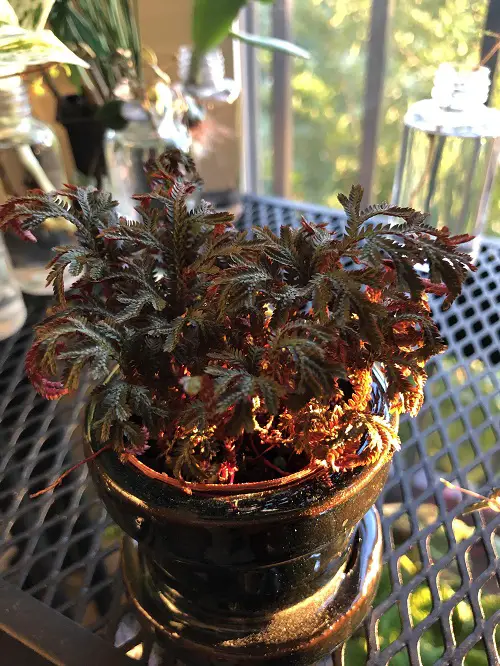Read all about How To Grow Red Fern Plants to learn more about these intriguing specimens and add them to your home decor!

Red Fern Plants are a stunning addition to any home or garden, with their striking color and graceful fronds. However, like other plants, they require proper attention to thrive. Let’s see how to take care of them!
Botanical Name: Selaginella erythropus
USDA Zones: 6-10
Check out the most colorful ferns
Choosing a Pot for Growing Red Fern Plants
As fern’s roots are shallow, so short containers are ideal for them. You can start these plants in an 8-10-inch pot and then keep on re-potting to one size bigger container according to their growth and spread.
Propagating Red Fern Plants
Red ferns can be propagated in a variety of ways. The most popular method is division.
- Remove the Red Fern Plant from its pot and gently loosen up the soil around the roots.
- Then, carefully divide it into two or more parts by softly tugging and pulling apart the rhizomes.
- Now, plant each section in a new pot with fresh potting soil. Ensure that the soil is moist at all times but not waterlogged.
- Place the babies in a spot with bright, indirect light and humidity above 50 percent.
- You can also use a plastic bag or a cloche as a cover to help maintain humidity.
- Water the new Red Fern Plants regularly. Keep the soil moist but not waterlogged.
- Let them grow until they become established in 3-5 weeks.
You can also propagate red ferns from seed. To do this, fill a pot with a well-draining potting mix and sow the seeds on top. Gently press them into the soil and water lightly. Keep the pot in a warm, sunny spot, and water regularly. The seeds should germinate in around four weeks.
Look at the Ferns that Look Like Spider Legs
Requirements for Growing Red Fern Plants

Sunlight
To ensure the health and longevity of your Red Fern Plants, it’s crucial to consider a bright, sunny location where your fern plant will get at least 6 hours of indirect sunlight every day.
Exposing it to light is crucial for the magical red color of the fronds that can dull in the shade. The best is to keep it in the mild morning sun daily for 2-3 hours.
Soil
Choosing the proper soil mixture is one of the most important aspects of growing Red Fern Plants. They need a soil mix that drains well, is nutrient-rich, and can hold moisture.
A good soil mix for ferns would be a combination of equal parts potting soil, compost, and perlite or coarse sand. Adding a bit of peat moss or sphagnum moss to the mix will help keep the soil moist and acidic.
Watering
Red Fern Plants may suffer from root rot or dehydration if you over or underwater them. Water these plants only when the topsoil is slightly dry to the touch.
Do not water the plant daily under any circumstances. Also, never let the soil go dry completely.
Temperature and Humidity
The plant prefers temperatures between 60-75°F or 15-24°C. It can tolerate slightly cooler temperatures, but you should protect the plant from frost and cold drafts.
It prefers high humidity levels of 50 percent or more. If the air in your home is dry, you can consider placing the plant on a tray of pebbles filled with water to increase humidity levels around the plant.
Alternatively, you can use a humidifier to increase the humidity in the room.
Red Fern Plants Care
Fertilizer
Using a balanced, water-soluble fertilizer can help your fern thrive. Fertilize Red Fern Plants once a month during the growing season and then cut back fertilization in the fall and winter.
Be sure to dilute the feed to half the strength to avoid burning the delicate roots of the plant.
Remember that overfertilizing outdoor ferns might cause the outer fronds or tips of the fronds to become brown.
Pests and Diseases
Red Fern Plants can be prone to spider mites and mealybugs. Watch out for any signs of infestation, such as webbing or tiny white bugs, and treat the plant with insecticidal soap or neem oil if necessary.
To avoid root rot, refrain from overwatering the plant.




